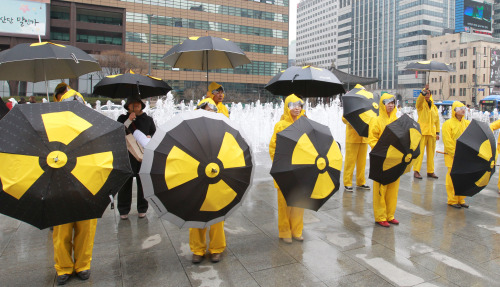Seoul to set up task force to handle Tokyo’s release of radioactive waterHeavy rains, expected to fall Thursday, will not contain radioactive materials released directly from the crippled Japanese nuclear plant, Korea’s weather agency said Wednesday.
Citizens here have expressed concerns over “radioactive rainfall” that would continue for a prolonged period following the widening nuclear crisis in quake-hit Japan.
Adding to the atomic fears, weather agencies in Norway and Germany, respectively, warned earlier this week that radioactive materials will reach the Korean Peninsula in the coming five days.
However, the Korea Meteorological Administration on Wednesday dismissed the overseas forecasts, saying the air current near the nuclear power plant has shifted to east.
“Based on the observation conducted as of 6 a.m. this morning, it is unlikely that the air current would blow directly from Fukushima to Korea over the next 72 hours,” said Kim Seung-bae, a spokesperson for the Korean weather agency.
“The rainfall will start in the nation’s western coast on Thursday and spread nationwide until Friday morning.”
Kim said the seasonal rainfalls could contain air pollutants, yellow dust from China and, this time, some radioactive materials of lowered concentration as they are traveling around the world on the westerly wind.
He made it clear that Japanese radioactive materials have yet to arrive in Korea directly on the prevailing wind.

(Yonhap News)
Yun Choul-ho, president of the Korea Institute of Nuclear Safety, also predicted that airborne radiation, regardless of its traveling route, would have almost no impact in Korea.
“We are carefully monitoring the air quality of Japan and the radiation levels are continuing to be lowered recently. Considering the situation in Japan, the amounts arriving in Korea would be too small to pose a health risk,” he said.
Despite the modest impact expected, the state-run nuclear regulator said it has started a real-time monitoring of the radiation levels of Japan’s Kagoshima, Nagasaki and Okinawa whose air current is closely connected to that of Korea.
KINS also strengthened its air quality surveillance in Jeju Island, which is to be affected first by the radiation release from Japan, conducting a sampling test every three hours.
As of Wednesday morning, the radiation levels in the Japanese checkpoints and Jeju remained normal, KINS said.
Meanwhile, in a meeting with South Korean officials over their complaint on not notifying Seoul about the discharge beforehand, Japan promised to stop discharging water “should any kind of danger be detected,” a Foreign Ministry official said.
“Japan said it has been and will continue closely monitoring the nearby seas and stop discharging water should any contamination be detected,” the Seoul official said on the customary condition of anonymity.
Saying they “deeply understand” Seoul’s concerns about not having been notified beforehand, Japanese officials emphasized South Korea was the first country Tokyo has informed of anything related to the discharge of radioactive water.
“They denied having informed the U.S. beforehand, explaining American experts who are currently dispatched in the region probably notified their government,” the Seoul official said.
In a separate meeting of related ministries earlier Wednesday, the Seoul government decided to soon set up a taskforce to oversee issues related to Tokyo’s continuing release of radioactive water, he added.
Tokyo’s failure to notify Seoul of the discharge have made some Koreans call to mind that in June 2009, North Korea had unleashed water from an upstream dam without prior notice, causing a flash flood that killed six South Koreans camping near the inter-Korean border. The reclusive state notified the South last summer before releasing the dam water for flood prevention during the monsoon season.
President Lee Myung-bak on Wednesday called for prompt and accurate public disclosure of possible radioactive contamination in foods including dairy products for infants.
“Because Korea is geographically close to Japan, people feel more anxious here compared to far away countries like the U.S. or Europe,” Lee said as he received reports at the Korea Food and Drug Administration in Osong, North Chungcheong Province.
“Koreans have high expectations for food safety, so (the government) should take extra efforts in safety inspection of imported foods. Even if the detected radioactivity falls below the (government-set) standards, we must inspect precisely and inform (the public) of the results promptly and accurately.”
By Lee Ji-yoon and Shin Hae-in
(
jylee@heraldcorp.com) (hayney@heraldcorp.com) (sophie@heraldcorp.com)






